engine GENESIS GV80 2021 Owner's Manual
[x] Cancel search | Manufacturer: GENESIS, Model Year: 2021, Model line: GV80, Model: GENESIS GV80 2021Pages: 632, PDF Size: 9.37 MB
Page 6 of 632
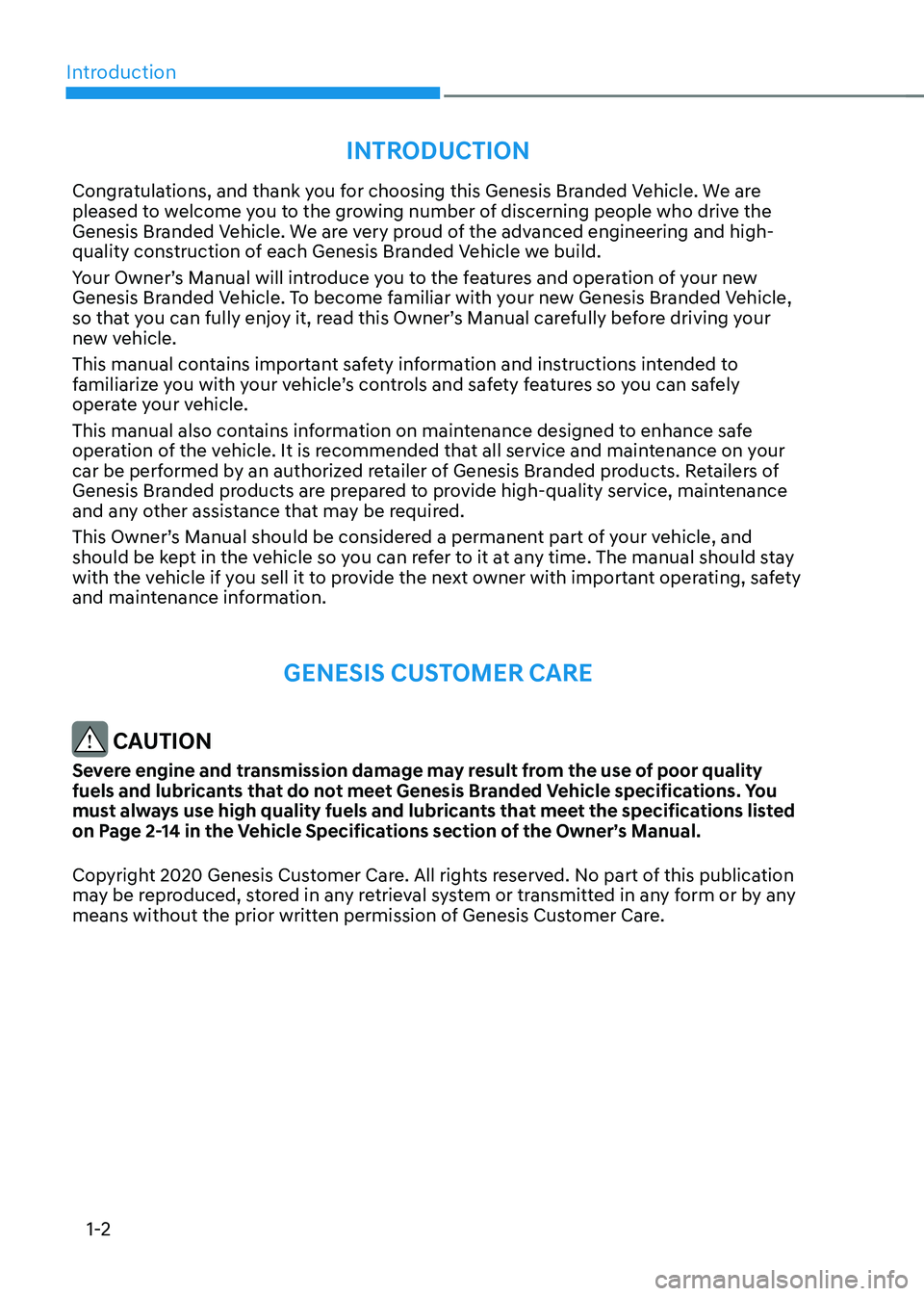
Introduction
1-2
INTRODUCTION
Congratulations, and thank you for choosing this Genesis Branded Vehicle. We are
pleased to welcome you to the growing number of discerning people who drive the
Genesis Branded Vehicle. We are very proud of the advanced engineering and high-
quality construction of each Genesis Branded Vehicle we build.
Your Owner’s Manual will introduce you to the features and operation of your new
Genesis Branded Vehicle. To become familiar with your new Genesis Branded Vehicle,
so that you can fully enjoy it, read this Owner’s Manual carefully before driving your
new vehicle.
This manual contains important safety information and instructions intended to
familiarize you with your vehicle’s controls and safety features so you can safely
operate your vehicle.
This manual also contains information on maintenance designed to enhance safe
operation of the vehicle. It is recommended that all service and maintenance on your
car be performed by an authorized retailer of Genesis Branded products. Retailers of
Genesis Branded products are prepared to provide high-quality service, maintenance
and any other assistance that may be required.
This Owner’s Manual should be considered a permanent part of your vehicle, and
should be kept in the vehicle so you can refer to it at any time. The manual should stay
with the vehicle if you sell it to provide the next owner with important operating, safety
and maintenance information.
GENESIS CUSTOMER CARE
CAUTION
Severe engine and transmission damage may result from the use of poor quality
fuels and lubricants that do not meet Genesis Branded Vehicle specifications. You
must always use high quality fuels and lubricants that meet the specifications listed
on Page 2-14 in the Vehicle Specifications section of the Owner’s Manual.
Copyright 2020 Genesis Customer Care. All rights reserved. No part of this publication
may be reproduced, stored in any retrieval system or transmitted in any form or by any
means without the prior written permission of Genesis Customer Care.
Page 9 of 632
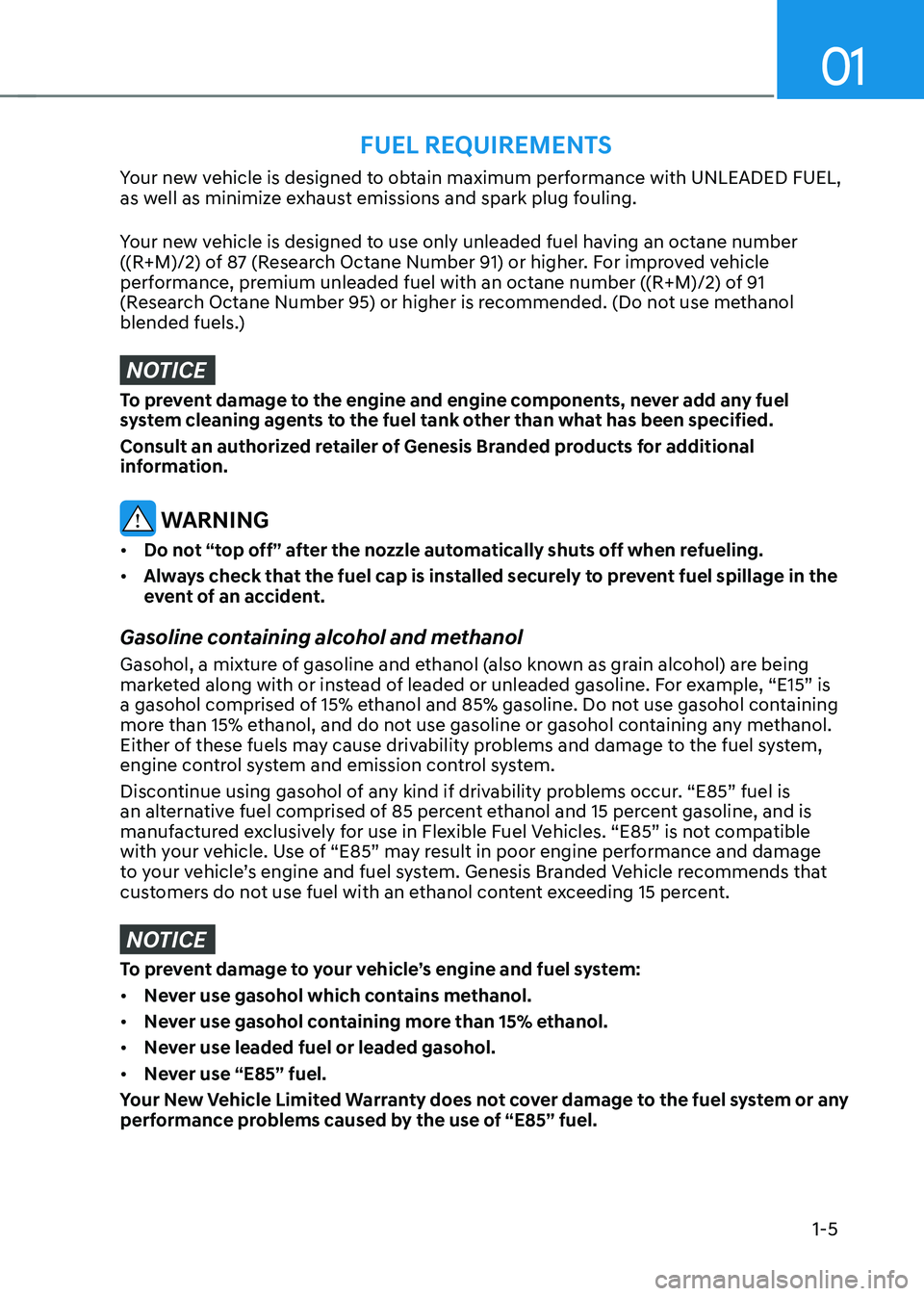
01
1-5
Your new vehicle is designed to obtain maximum performance with UNLEADED FUEL,
as well as minimize exhaust emissions and spark plug fouling.
Your new vehicle is designed to use only unleaded fuel having an octane number
((R+M)/2) of 87 (Research Octane Number 91) or higher. For improved vehicle
performance, premium unleaded fuel with an octane number ((R+M)/2) of 91
(Research Octane Number 95) or higher is recommended. (Do not use methanol
blended fuels.)
NOTICE
To prevent damage to the engine and engine components, never add any fuel
system cleaning agents to the fuel tank other than what has been specified.
Consult an authorized retailer of Genesis Branded products for additional
information.
WARNING
• Do not “top off” after the nozzle automatically shuts off when refueling.
• Always check that the fuel cap is installed securely to prevent fuel spillage in the
event of an accident.
Gasoline containing alcohol and methanol
Gasohol, a mixture of gasoline and ethanol (also known as grain alcohol) are being
marketed along with or instead of leaded or unleaded gasoline. For example, “E15” is
a gasohol comprised of 15% ethanol and 85% gasoline. Do not use gasohol containing
more than 15% ethanol, and do not use gasoline or gasohol containing any methanol.
Either of these fuels may cause drivability problems and damage to the fuel system,
engine control system and emission control system.
Discontinue using gasohol of any kind if drivability problems occur. “E85” fuel is
an alternative fuel comprised of 85 percent ethanol and 15 percent gasoline, and is
manufactured exclusively for use in Flexible Fuel Vehicles. “E85” is not compatible
with your vehicle. Use of “E85” may result in poor engine performance and damage
to your vehicle’s engine and fuel system. Genesis Branded Vehicle recommends that
customers do not use fuel with an ethanol content exceeding 15 percent.
NOTICE
To prevent damage to your vehicle’s engine and fuel system:
• Never use gasohol which contains methanol.
• Never use gasohol containing more than 15% ethanol.
• Never use leaded fuel or leaded gasohol.
• Never use “E85” fuel.
Your New Vehicle Limited Warranty does not cover damage to the fuel system or any
performance problems caused by the use of “E85” fuel.
FUEL REQUIREMENTS
Page 10 of 632
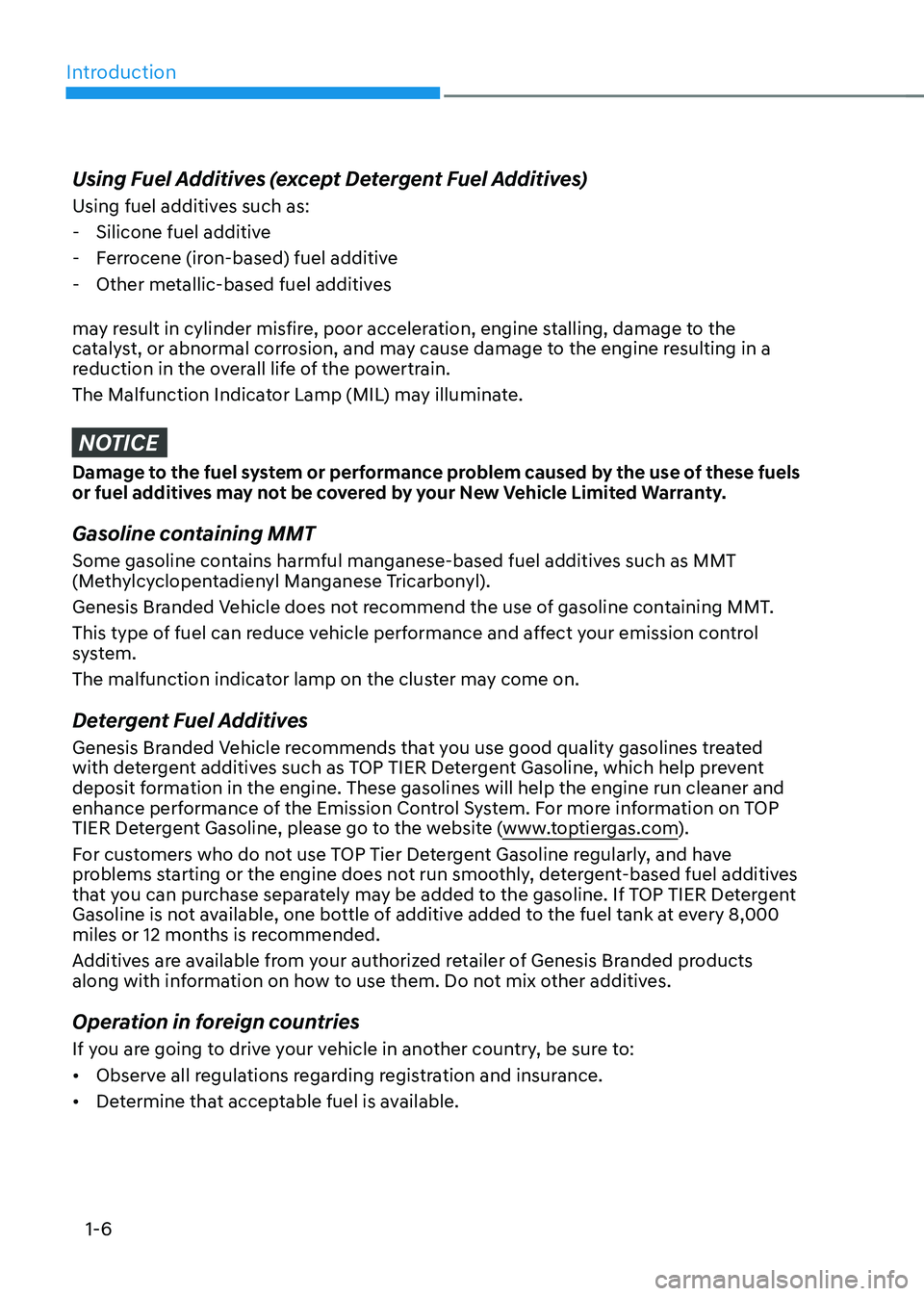
Introduction
1-6
Using Fuel Additives (except Detergent Fuel Additives)
Using fuel additives such as:
-Silicone fuel additive
-Ferrocene (iron-based) fuel additive
-Other metallic-based fuel additives
may result in cylinder misfire, poor acceleration, engine stalling, damage to the
catalyst, or abnormal corrosion, and may cause damage to the engine resulting in a
reduction in the overall life of the powertrain.
The Malfunction Indicator Lamp (MIL) may illuminate.
NOTICE
Damage to the fuel system or performance problem caused by the use of these fuels
or fuel additives may not be covered by your New Vehicle Limited Warranty.
Gasoline containing MMT
Some gasoline contains harmful manganese-based fuel additives such as MMT
(Methylcyclopentadienyl Manganese Tricarbonyl).
Genesis Branded Vehicle does not recommend the use of gasoline containing MMT.
This type of fuel can reduce vehicle performance and affect your emission control
system.
The malfunction indicator lamp on the cluster may come on.
Detergent Fuel Additives
Genesis Branded Vehicle recommends that you use good quality gasolines treated
with detergent additives such as TOP TIER Detergent Gasoline, which help prevent
deposit formation in the engine. These gasolines will help the engine run cleaner and
enhance performance of the Emission Control System. For more information on TOP
TIER Detergent Gasoline, please go to the website ( www.toptiergas.com).
For customers who do not use TOP Tier Detergent Gasoline regularly, and have
problems starting or the engine does not run smoothly, detergent-based fuel additives
that you can purchase separately may be added to the gasoline. If TOP TIER Detergent
Gasoline is not available, one bottle of additive added to the fuel tank at every 8,000
miles or 12 months is recommended.
Additives are available from your authorized retailer of Genesis Branded products
along with information on how to use them. Do not mix other additives.
Operation in foreign countries
If you are going to drive your vehicle in another country, be sure to:
• Observe all regulations regarding registration and insurance.
• Determine that acceptable fuel is available.
Page 11 of 632
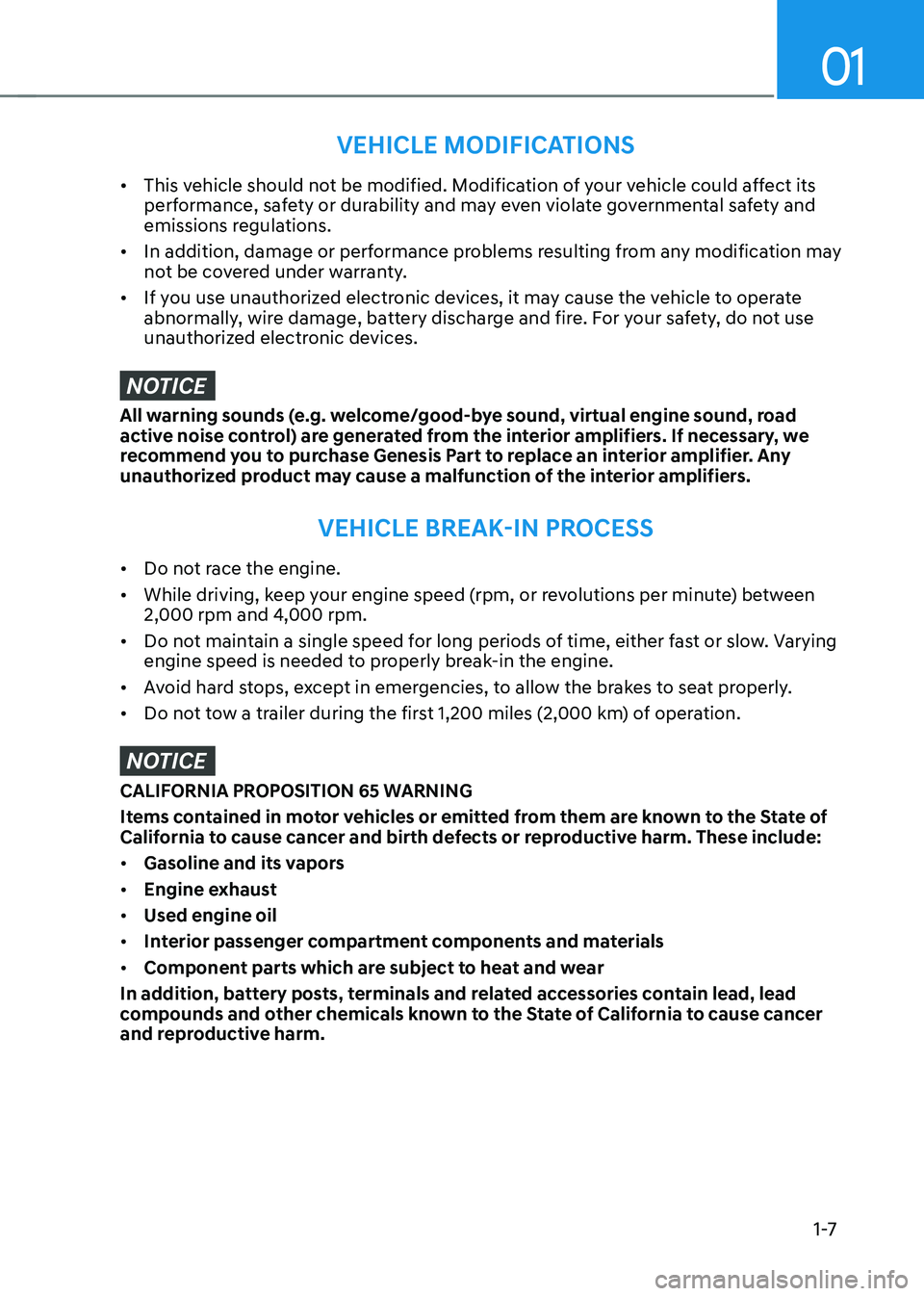
01
1 -7
VEHICLE MODIFICATIONS
• This vehicle should not be modified. Modification of your vehicle could affect its
performance, safety or durability and may even violate governmental safety and
emissions regulations.
• In addition, damage or performance problems resulting from any modification may
not be covered under warranty.
• If you use unauthorized electronic devices, it may cause the vehicle to operate
abnormally, wire damage, battery discharge and fire. For your safety, do not use
unauthorized electronic devices.
NOTICE
All warning sounds (e.g. welcome/good-bye sound, virtual engine sound, road
active noise control) are generated from the interior amplifiers. If necessary, we
recommend you to purchase Genesis Part to replace an interior amplifier. Any
unauthorized product may cause a malfunction of the interior amplifiers.
VEHICLE BREAK-IN PROCESS
• Do not race the engine.
• While driving, keep your engine speed (rpm, or revolutions per minute) between
2,000 rpm and 4,000 rpm.
• Do not maintain a single speed for long periods of time, either fast or slow. Varying
engine speed is needed to properly break-in the engine.
• Avoid hard stops, except in emergencies, to allow the brakes to seat properly.
• Do not tow a trailer during the first 1,200 miles (2,000 km) of operation.
NOTICE
CALIFORNIA PROPOSITION 65 WARNING
Items contained in motor vehicles or emitted from them are known to the State of
California to cause cancer and birth defects or reproductive harm. These include:
• Gasoline and its vapors
• Engine exhaust
• Used engine oil
• Interior passenger compartment components and materials
• Component parts which are subject to heat and wear
In addition, battery posts, terminals and related accessories contain lead, lead
compounds and other chemicals known to the State of California to cause cancer
and reproductive harm.
Page 13 of 632
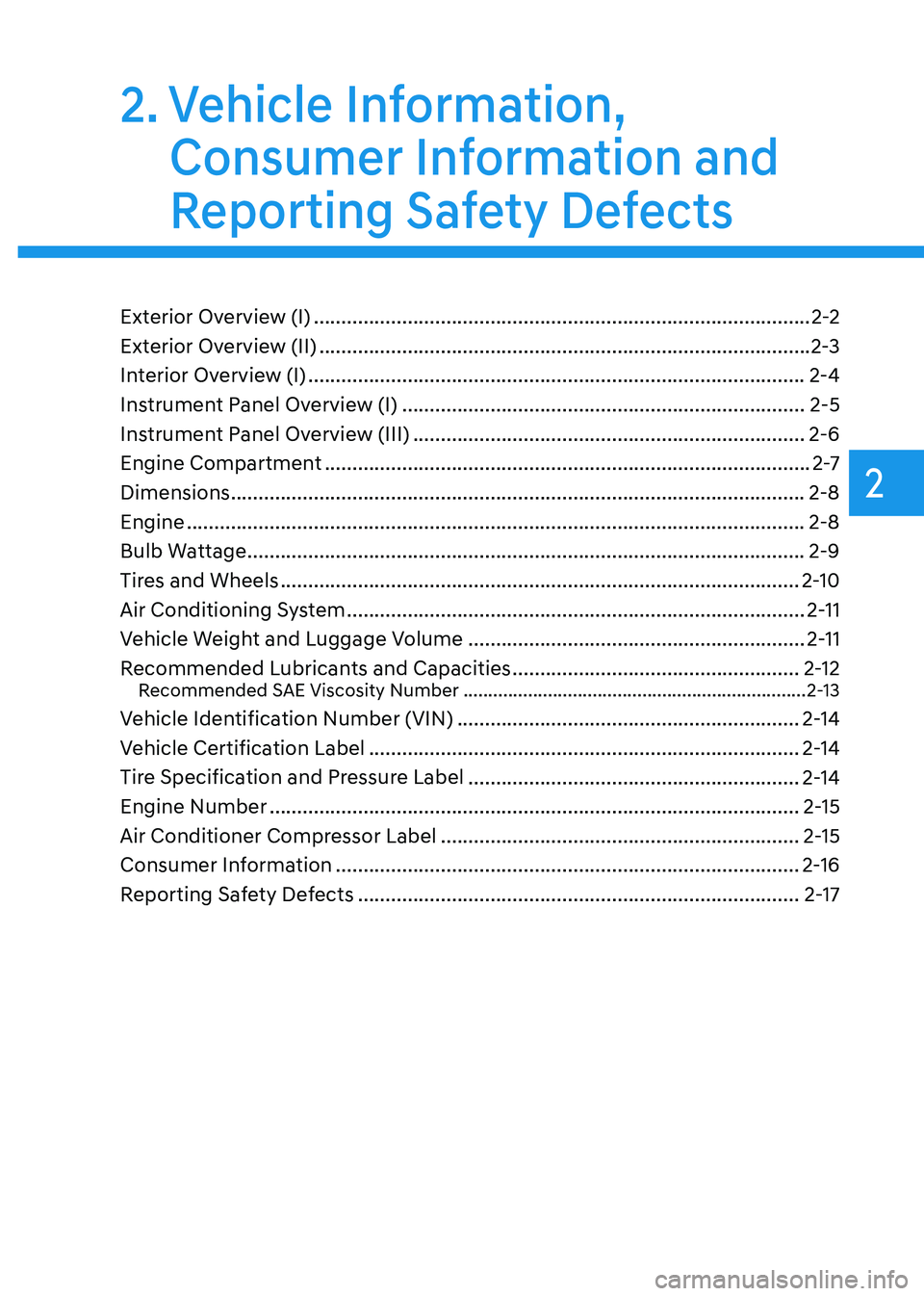
2. Vehicle Information,
Consumer Information and
Reporting Safety Defects
Exterior Overview (I) ........................................................................\
..................2-2
Exterior Overview (II)
........................................................................\
.................2-3
Interior Overview (I)
........................................................................\
..................2-4
Instrument Panel Overview (I)
........................................................................\
.2-5
Instrument Panel Overview (III)
.......................................................................2-6
Engine Compartment
........................................................................\
................2-7
Dimensions
........................................................................\
................................2-8
Engine
........................................................................\
........................................2-8
Bulb Wattage
........................................................................\
.............................2-9
Tires and Wheels
........................................................................\
......................2-10
Air Conditioning System
........................................................................\
...........2-11
Vehicle Weight and Luggage Volume
.............................................................2-11
Recommended Lubricants and Capacities
....................................................2-12Recommended SAE Viscosity Number .....................................................................2-13
Vehicle Identification Number (VIN) ..............................................................2-14
Vehicle Certification Label
........................................................................\
......2-14
Tire Specification and Pressure Label
............................................................2-14
Engine Number
........................................................................\
........................2-15
Air Conditioner Compressor Label
.................................................................2-15
Consumer Information
........................................................................\
............2-16
Reporting Safety Defects
........................................................................\
........2-17
Vehicle Information, Consumer Information and Reporting Safety Defects
2
Page 17 of 632
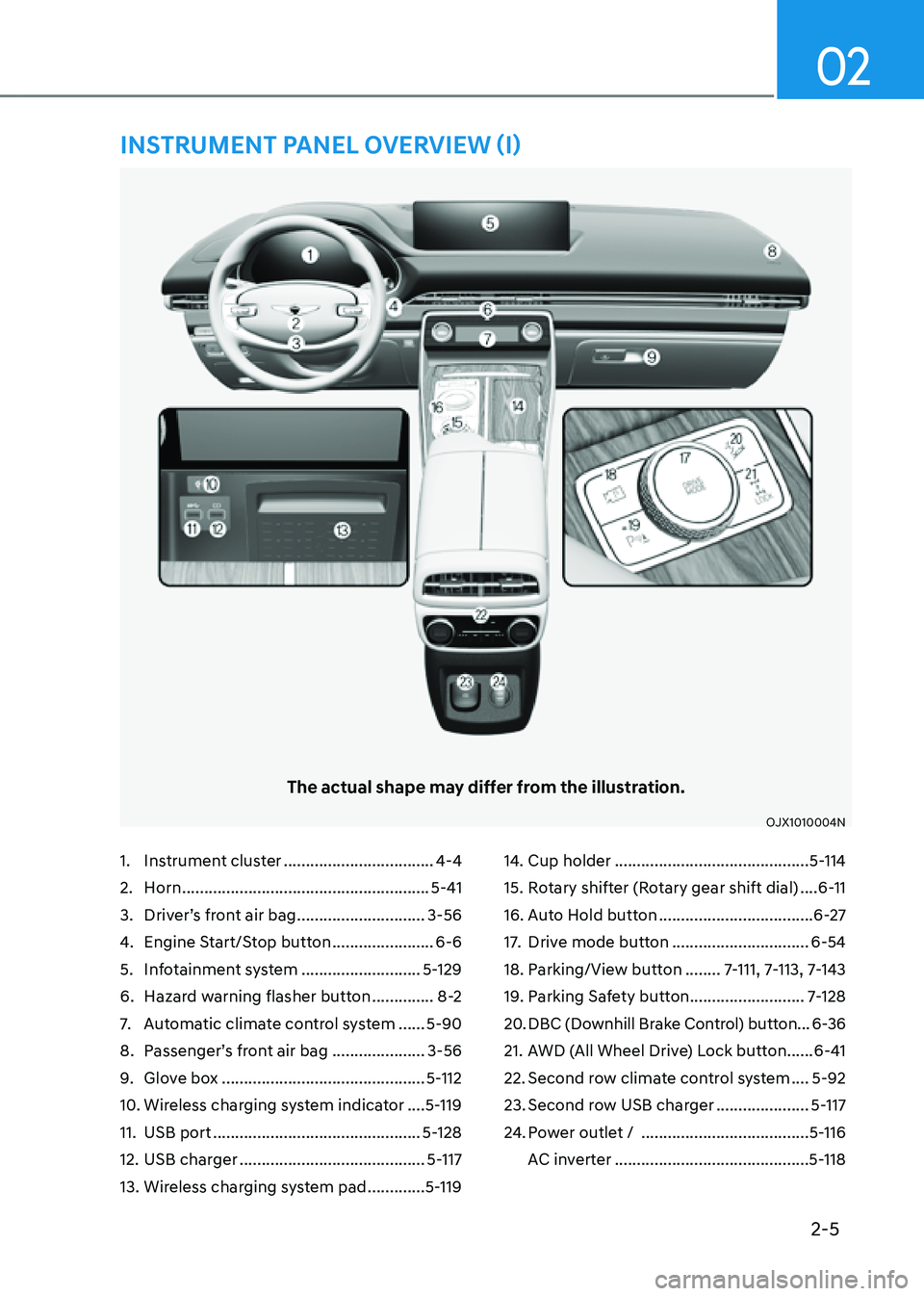
2-5
02
1. Instrument cluster ..................................4-4
2. Horn ........................................................5-41
3. Driver’s front air bag .............................3-56
4. Engine Start/Stop button .......................6-6
5. Infotainment system ...........................5-129
6. Hazard warning flasher button ..............8-2
7. Automatic climate control system ......5-90
8. Passenger’s front air bag .....................3-56
9. Glove box ..............................................5-112
10. Wireless charging system indicator ....5-119
11. USB port ...............................................5-128
12. USB charger ..........................................5-117
13. Wireless charging system pad .............5-119
14. Cup holder ............................................5-114
15. Rotary shifter (Rotary gear shift dial) ....6-11
16. Auto Hold button ...................................6-27
17. Drive mode button ...............................6-54
18. Parking/View button ........7-111, 7-113, 7-143
19. Parking Safety button ..........................7-128
20. DBC (Downhill Brake Control) button ...6-36
21. AWD (All Wheel Drive) Lock button ......6-41
22. Second row climate control system ....5-92
23. Second row USB charger .....................5-117
24. Power outlet / ......................................5-116
AC inverter
............................................5-118
The actual shape may differ from the illustration.
OJX1010004NOJX1010004N
INSTRUMENT PANEL OVERVIEW (I)
Page 19 of 632
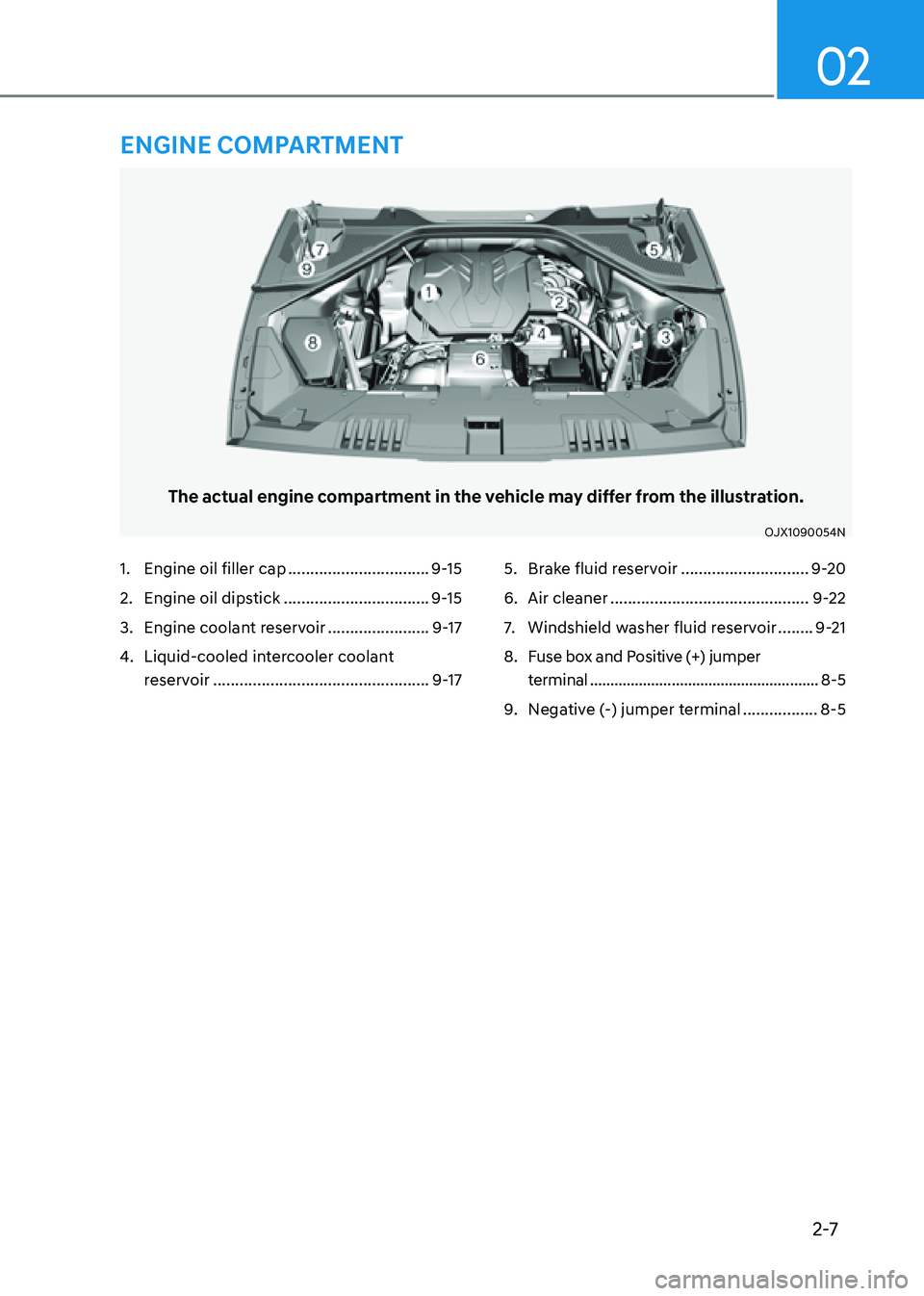
2-7
02
The actual engine compartment in the vehicle may differ from the illustration.
OJX1090054NOJX1090054N
1. Engine oil filler cap ................................9-15
2. Engine oil dipstick .................................9-15
3. Engine coolant reservoir .......................9-17
4. Liquid-cooled intercooler coolant
reservoir
.................................................9-17
5. Brake fluid reservoir .............................9-20
6. Air cleaner .............................................9-22
7. Windshield washer fluid reservoir ........9-21
8. Fuse box and Positive (+) jumper
terminal
........................................................8-5
9. Negative (-) jumper terminal .................8-5
ENGINE COMPARTMENT
Page 20 of 632
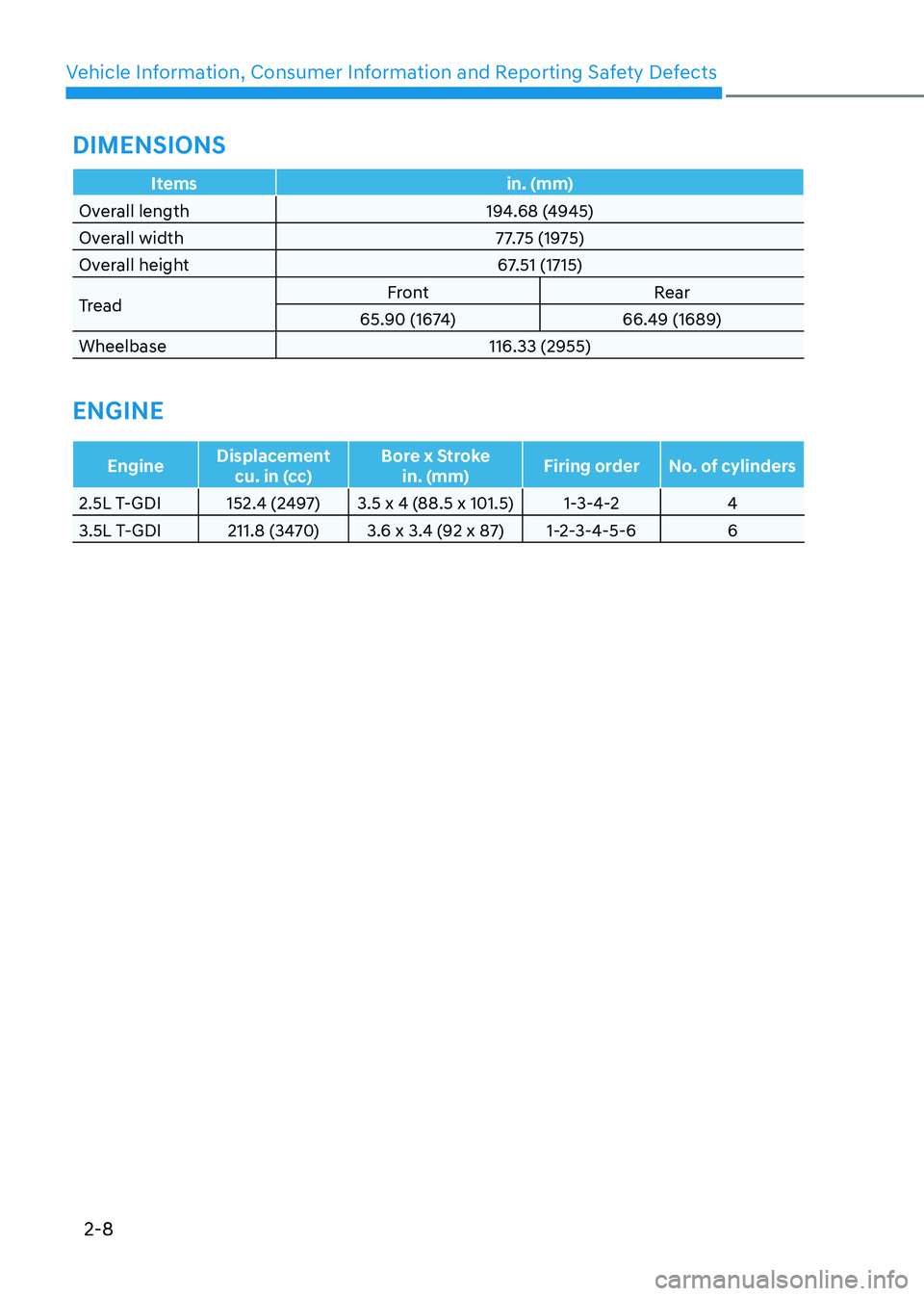
Vehicle Information, Consumer Information and Reporting Safety Defects
2-8
Itemsin. (mm)
Overall length 194.68 (4945)
Overall width 77.75 (1975)
Overall height 67.51 (1715)
Tread Front
Rear
65.90 (1674) 66.49 (1689)
Wheelbase 116.33 (2955)
ENGINE
EngineDisplacement
cu. in (cc) Bore x Stroke
in. (mm) Firing order
No. of cylinders
2.5L T-GDI 152.4 (2497)3.5 x 4 (88.5 x 101.5) 1-3-4-24
3.5L T-GDI 211.8 (3470) 3.6 x 3.4 (92 x 87) 1-2-3-4-5-6 6
DIMENSIONS
Page 24 of 632
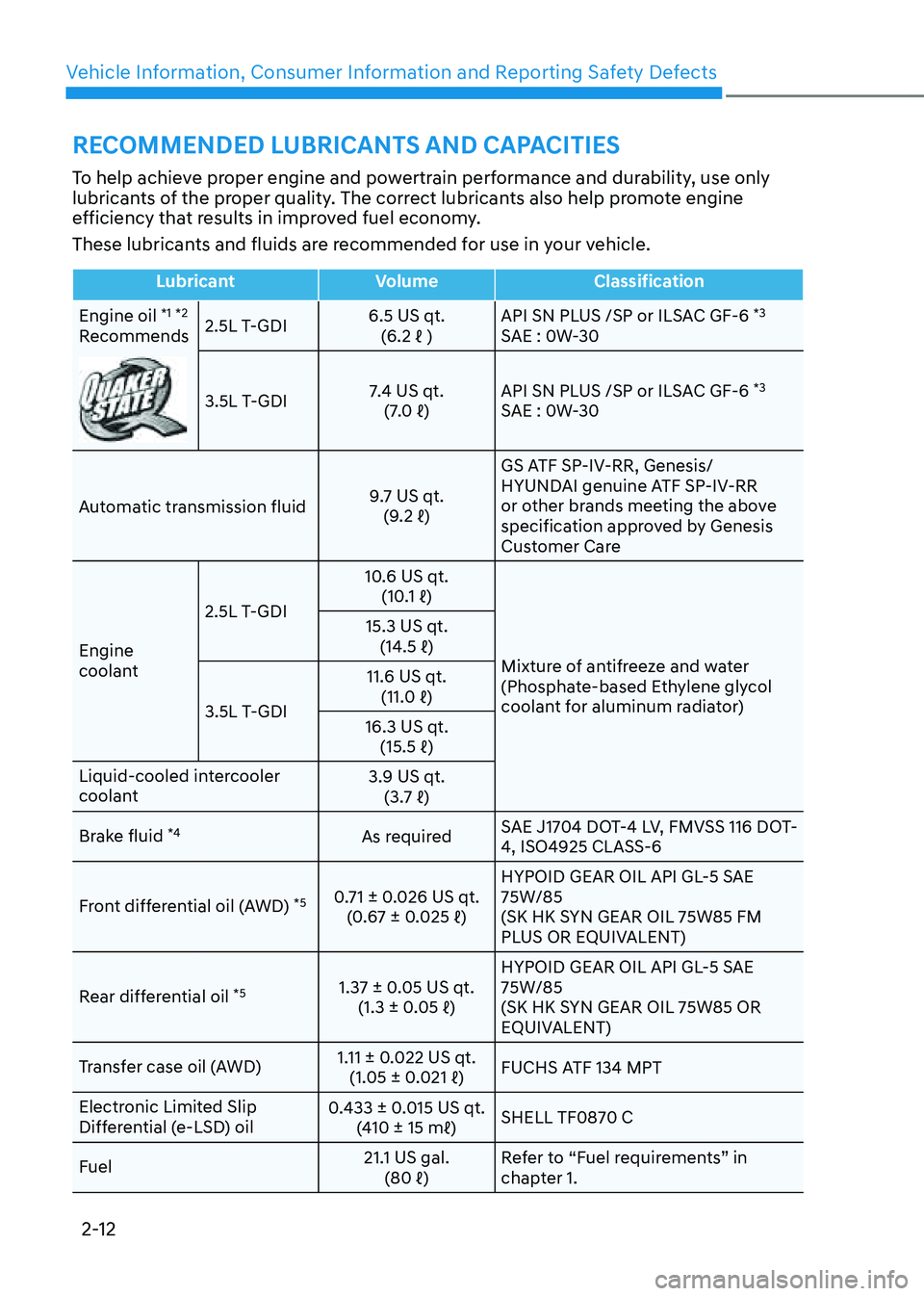
Vehicle Information, Consumer Information and Reporting Safety Defects
2-12
To help achieve proper engine and powertrain performance and durability, use only
lubricants of the proper quality. The correct lubricants also help promote engine
efficiency that results in improved fuel economy.
These lubricants and fluids are recommended for use in your vehicle.
LubricantVolumeClassification
Engine oil
*1 *2
Recommends 2.5L T-GDI 6.5 US qt.
(6.2 ℓ ) API SN PLUS /SP or ILSAC GF-6 *3
SAE : 0W-30
3.5L T-GDI7.4 US qt.
(7.0 ℓ) API SN PLUS /SP or ILSAC GF-6 *3
SAE : 0W-30
Automatic transmission fluid 9.7 US qt.
(9.2 ℓ) GS ATF SP-IV-RR, Genesis/
HYUNDAI genuine ATF SP-IV-RR
or other brands meeting the above
specification approved by Genesis
Customer Care
Engine
coolant 2.5L T-GDI
10.6 US qt.
(10.1 ℓ)
Mixture of antifreeze and water
(Phosphate-based Ethylene glycol
coolant for aluminum radiator)
15.3 US qt.
(14.5 ℓ)
3.5L T-GDI 11.6 US qt.
(11.0 ℓ)
16.3 US qt. (15.5 ℓ)
Liquid-cooled intercooler
coolant 3.9 US qt.
(3.7 ℓ)
Brake fluid
*4As required SAE J1704 DOT-4 LV, FMVSS 116 DOT-
4, ISO4925 CLASS-6
Front differential oil (AWD)
*50.71 ± 0.026 US qt. (0.67 ± 0.025 ℓ) HYPOID GEAR OIL API GL-5 SAE
75W/85
(SK HK SYN GEAR OIL 75W85 FM
PLUS OR EQUIVALENT)
Rear differential oil
*51.37 ± 0.05 US qt. (1.3 ± 0.05 ℓ) HYPOID GEAR OIL API GL-5 SAE
75W/85
(SK HK SYN GEAR OIL 75W85 OR
EQUIVALENT)
Transfer case oil (AWD) 1.11 ± 0.022 US qt.
(1.05 ± 0.021 ℓ) FUCHS ATF 134 MPT
Electronic Limited Slip
Differential (e-LSD) oil 0.433 ± 0.015 US qt.
(410 ± 15 mℓ) SHELL TF0870 C
Fuel 21.1 US gal.
(80 ℓ) Refer to “Fuel requirements” in
chapter 1.
RECOMMENDED LUBRICANTS AND CAPACITIES
Page 25 of 632
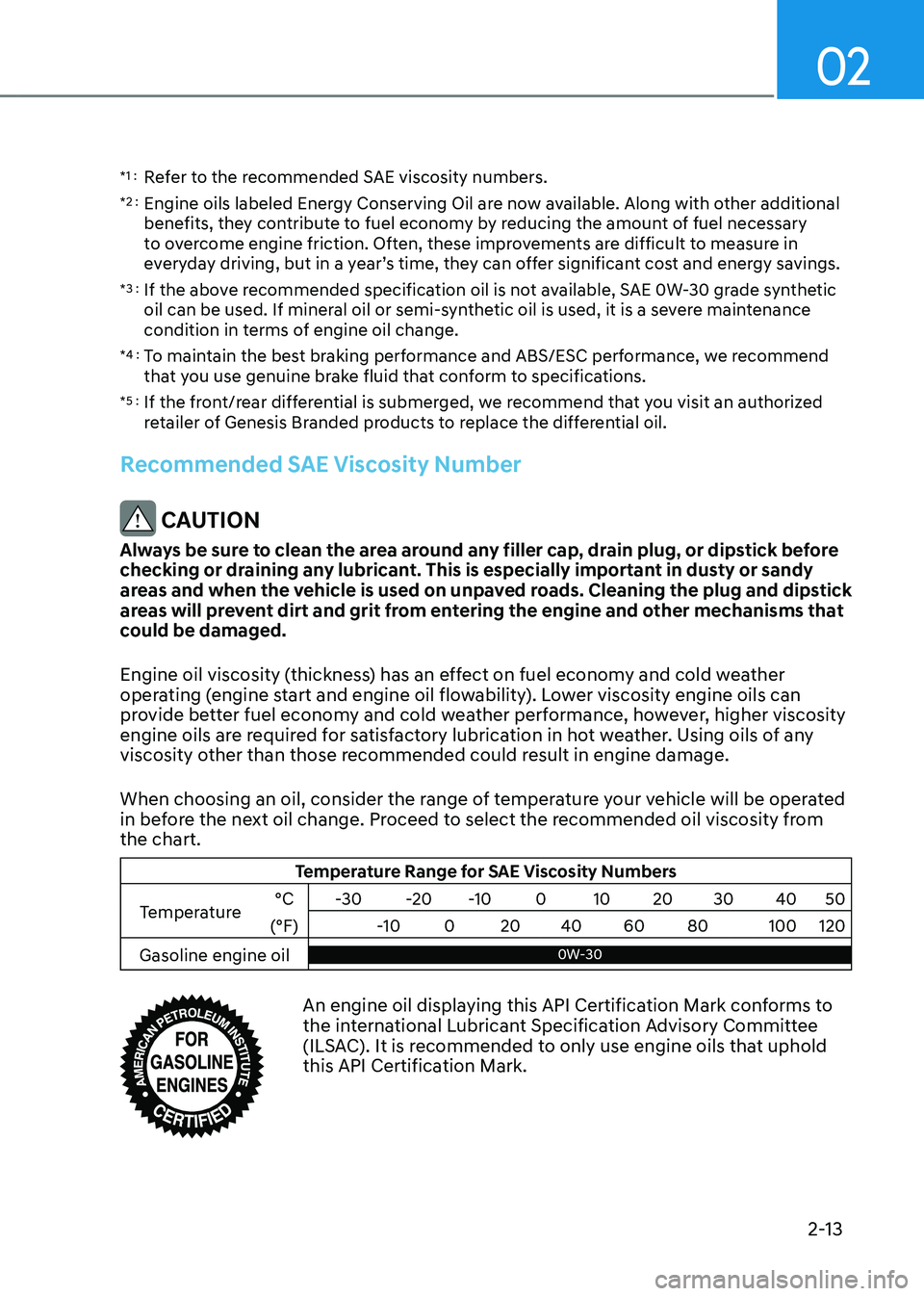
02
2-13
*1 : Refer to the recommended SAE viscosity numbers.
*2 : Engine oils labeled Energy Conserving Oil are now available. Along with other additional
benefits, they contribute to fuel economy by reducing the amount of fuel necessary
to overcome engine friction. Often, these improvements are difficult to measure in
everyday driving, but in a year’s time, they can offer significant cost and energy savings.
*3 : If the above recommended specification oil is not available, SAE 0W-30 grade synthetic
oil can be used. If mineral oil or semi-synthetic oil is used, it is a severe maintenance
condition in terms of engine oil change.
*4 : To maintain the best braking performance and ABS/ESC performance, we recommend
that you use genuine brake fluid that conform to specifications.
*5 : If the front/rear differential is submerged, we recommend that you visit an authorized
retailer of Genesis Branded products to replace the differential oil.
Recommended SAE Viscosity Number
CAUTION
Always be sure to clean the area around any filler cap, drain plug, or dipstick before
checking or draining any lubricant. This is especially important in dusty or sandy
areas and when the vehicle is used on unpaved roads. Cleaning the plug and dipstick
areas will prevent dirt and grit from entering the engine and other mechanisms that
could be damaged.
Engine oil viscosity (thickness) has an effect on fuel economy and cold weather
operating (engine start and engine oil flowability). Lower viscosity engine oils can
provide better fuel economy and cold weather performance, however, higher viscosity
engine oils are required for satisfactory lubrication in hot weather. Using oils of any
viscosity other than those recommended could result in engine damage.
When choosing an oil, consider the range of temperature your vehicle will be operated
in before the next oil change. Proceed to select the recommended oil viscosity from
the chart.
Temperature Range for SAE Viscosity Numbers
Temperature °C
-30 -20-10 010 20 30 4050
(°F) -10020 40 60 80 100120
Gasoline engine oil
0W-300W-30
An engine oil displaying this API Certification Mark conforms to the international Lubricant Specification Advisory Committee
(ILSAC). It is recommended to only use engine oils that uphold
this API Certification Mark.